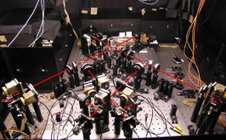July 15, 2008 feature
Getting many quantum states from one experimental setup

(PhysOrg.com) -- “In the traditional approach to entanglement with linear optics, one designs a new setup for each single state that you want,” Witlef Wieczorek tells PhysOrg.com. “What we’ve done is to make a single setup that allows you to observe lots of different quantum states.”
Wieczorek is a scientist at the Max Planck Institute for Quantum Optics in Garching and Ludwig-Maximilians-Universität Munich, Germany. He is part of a team that not only figured out how it might work to use one linear optics setup for several quantum states, but also demonstrated that such a setup works.
His colleagues include Christian Schmid, Nikolai Kiesel, Reinhold Pohlner and Harald Weinfurter at the Max Planck Institute and Ludwig-Maximilians-Universität, as well as Otfried Gühne at the Institute for Quantum Optics and Quantum Information in Innsbruck, Austria. Their work is reported in Physical Review Letters: “Experimental Observation of an Entire Family of Four-Photon Entangled States.”
“It is inefficient to have to keep changing the entire setup for each quantum state,” Wieczorek explains. “But now we’ve shown that you can have one setup, and if you change a parameter, you can get a different quantum state. You no longer have to design a different setup for each state.”
Wieczorek and his peers call the states “families” because they are “related” through the experimental setup, and only require the changing of an experimental parameter to get a new state. “We have a group of states that are connected to this one setup.” One of the most exciting things, however, is that this particular family includes five quantum states that are known to have applications in the field of quantum information.
“These quantum states are useful for different tasks,” Wieczorek says. “Our one setup produces states that can be used for decoherence-free communication, secret sharing of information, telecloning and getting different kinds of three qubit inequivalent entangled states.”
Known states are nice, but Wieczorek and his colleagues also found states not discussed before. While the unknown quantum states in this particular family do not have any known practical application right now, they can contribute to the overall knowledge of entanglement. “We can characterize the family better by studying particular properties, as, for example, entanglement robustness or persistency, of the family of states in more detail. And, who knows? Maybe these unknown states will have applications in the future.”
The current work is done with four photon entangled states, but Wieczorek hopes to expand the idea to six photon entangled states. “Next, we want to go for six photons,” he says. “And we have an idea of how we can apply it to the setup.”
For the most part, Wieczorek and his peers confined themselves to looking at only a small fraction of states. However, it is possible that any number of states could be achieved. “In principle, you could see a different state for each parameter you change. You could see infinetely many states.”
But for now, Wieczorek is happy with the results of what has been accomplished so far. “This makes it easier. We can say we want a state for a particular application, and we just set the parameter. When we’re ready to do something else, all we do is change the parameter.”
Copyright 2008 PhysOrg.com.
All rights reserved. This material may not be published, broadcast, rewritten or redistributed in whole or part without the express written permission of PhysOrg.com.




















